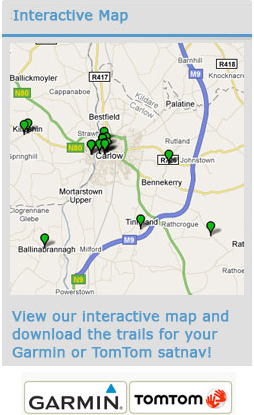St. Moling's Trail
Borris House
Borris House.
In the centre of the village is Borris House, which dates to the eighteenth century andstands on the site of a late medieval castle. The house is also the ancestral home of theMacMurrough Kavanagh family, who trace their descent from the MacMurrough Kings ofLeinster.
Borris – An Bhuiríos – Burgage Land
Borris is a granite, Georgian village, full of charm and heritage, situated in the fertile valley of the River Barrow, below the gentle curve of the Blackstairs Mountains.
1. Borris House dates to the eighteenth century and stands on the site of a late medieval castle. The house is also the ancestral home of the MacMurrough Kavanagh [...]
Ballinkillin – Baile an Chillín
4. St. Laserian’s Catholic Church is a large T barn building with a date stone of 1793, although the present structure probably dates from 1830. The church is painted and rendered with plain, pointed windows and one square-headed, granite door case.
In the churchyard you can see a large replica of a nineteenth century high cross erected [...]
Lorum – Leamhdhroim – Ridge or Long Hill of the Mallows
5. Church of Ireland church – Evidence of three different churches can be found on the site at Lorum. The nineteenth-century seven-bay church stands on elevated ground in a striking setting about 3.5 km from the River Barrow. It was built about 1838 to the design of Frederick Darley who also designed the gate piers [...]
Ballinree – Baile an Fhraoigh – Town of the Heath
6. Templemoling Cemetery. This peaceful site, in a beautiful landscape setting and enclosed by a well defined circular hedge contains the ephemeral remains of an early church site associated with St. Moling. One can also find here a stone reputed to show the footprint of St. Finian. When one visits the site it is easy [...]
Killoughternane – Cill Uchtarnáin – Church of Fortiarnán (Fortchern)
7. St. Fortiarnán’s church.
Against the backdrop of the Blackstairs Mountains stand the remains of this diminutive rectangular church which dates back to the tenth or eleventh century. It is testament to the building skills of these early stone masons that all four walls are still intact almost one thousand years after they were first built.
Known [...]
St. Mullins – Tigh Moling – The House of Moling
St. Mullins is beautifully situated on a high wooded promontory on the east bank of the River Barrow, overlooked by the Blackstairs Mountains to the east and Mount Brandon to the west. St. Mullins is one of the county’s most important archaeological sites containing aspects of both religious and secular history. It is very much [...]
St. Mullins – ecclesiastical ruins
9. St. Mullins – ecclesiastical ruins This important monastery was founded by St. Moling in the seventh century and it had close links with Ferns in Co. Wexford and Glendalough in Co. Wicklow. It has been a place of pilgrimage since medieval times and St. Moling’s Well is still venerated for its powers of healing.
DID [...]
St. Mullins – Holy Well
St. Mullins –Holy Well
The site has been a place of pilgrimage since medieval times and St. Moling’s Well is still venerated for its powers of healing. Friar Clyn, the Kilkenny chronicler reported that in 1349, while the Black Death was raging in the area, thousands of people made a pilgrimage to wade in the water [...]
Graiguenamanagh – Gráig na Manach – The grange of the Monks
A popular boating centre on the River Barrow whose character reflects a bygone time when the town was an important focal point for commercial boats. One of Ireland’s finest Cistercian monasteries was founded here in 1204 by William Marshal who became Lord of Leinster following his marriage to Strongbow’s daughter Isabel de Clare. It was called [...]
